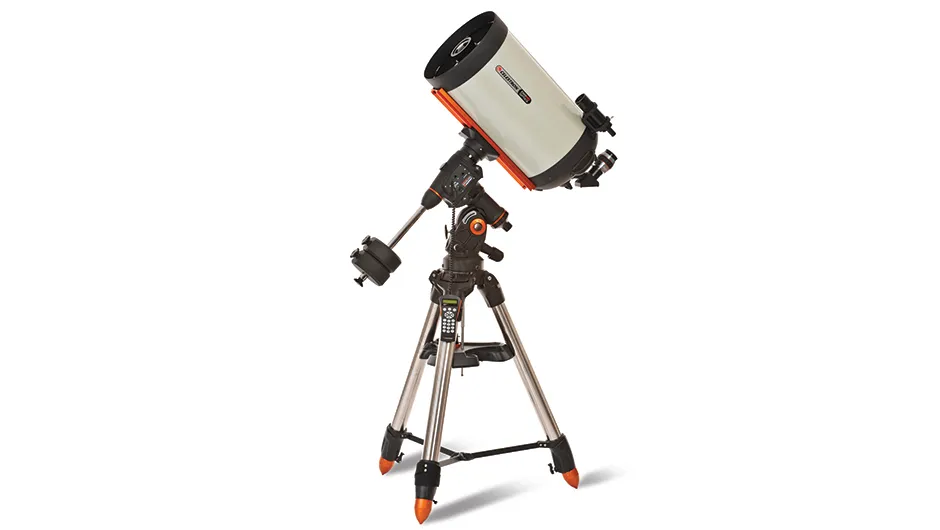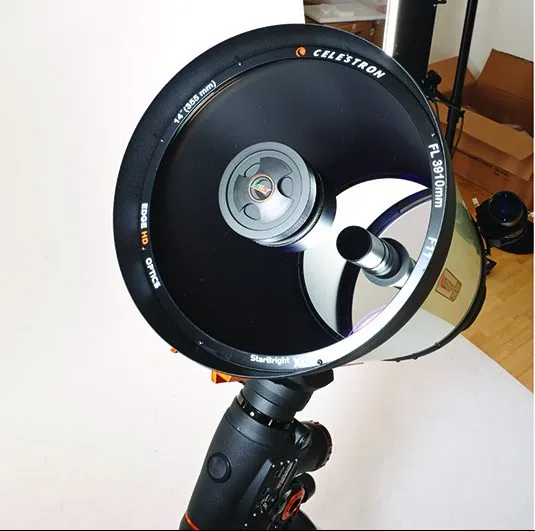Here we're looking at a computerised telescope package from Celestron that includes the company’s latest EdgeHD instrument, a 356mm (14-inch) diameter, f/11 aplanatic-Schmidt telescope.
This design uses folded optics to contain the scope’s 4m focal length in a tube a little less than 80cm long; that’s the Schmidt part.
The aplanatic part is a field flattener fitted in the exit tube just before the eyepiece.
By working with the other optical components, it produces a sharp, flat field right to the edge of the view.

The optics sit on a heavy-duty field tripod that supports a CGEM DX Go-To equatorial mount head.A rail on the scope slides into a lockable dovetail clamp on the mount head.
Lifting the 21kg tube safely is a task best suited to two pairs of hands, but the heavy-duty mount holds the tube extremely well and any wobbles are damped out very fast indeed.
You’ll need a 12V supply to operate the RA and Dec. drives, and the on-board Go-To computer.This has a 40,000-object database built in and is operated via a plug-in handset.
There’s no polarscope included, since polar alignment is handled by an ‘All-star Polar Alignment’ program operated via the mount’s handset.
The accuracy of the Go-To mount is okay, but the scope’s high magnification meant that we did have to make a few tweaks.
A higher-precision mode is also available, although this will involve aligning the scope on a nearby star.
The 1400 HD is the latest incarnation of Celestron’s C-14, a scope that has been consistently popular with lunar and planetary imagers.

Thisnew version has a number of updates, such as the field flattener, mirror locks and filtered tube vents.
The field flattener is designed to deliver coma-free stars right into the corners of large format sensors, such as those you’d find on a full-frame 35mm DSLR camera.
Comparing the results to an original C-14 without a field flattener, the stars were – as promised – noticeably improved.
A slight concern with the flattener is that for high-resolution lunar and planetary imaging, the flattener’s optics add more glass for the light to pass through.
Fortunately, in tests this didn’t seem to seriously detract from the quality of the results.
The light grasp of the EdgeHD 1400 is impressive.
The beauty of the Ring Nebula, M57, was easily visible with direct vision – the ring showing its elliptical form.
And even with mediocre seeing, we could see fleeting glimpses of M57’s dim, difficult central star with averted vision.
The supplied 23mm wide-angle, two-inch fit eyepiece complements the scope well.

Looking at deep-sky objects with it gives the impression that you’re floating in space with them.
In keeping with the rest of the scope, the eyepiece is a heavy beast.
Jupiter was magnificent.Its belts and zones were easy targets for direct vision, full of intricate detail and colour.
Swapping to a mono planetary camera, we imaged the planet using RGB filters.The optics produced impressive results for the conditions.
The focuser is adequate, but we did experience some image shift at high magnifications.For this type of imaging, it would have been nice to have had an in-line electric focuser included with the scope.
Our view of the Moon was incredibly crisp and detailed.

At high magnifications we were able to pick out some very small features, including sections of a narrow sinuous rille running down the centre of the Vallis Alpes – a feature that’s only 700m wide.
Ideal for lunar and planetary imaging, the scope also makes an impressive full high-res and fast wide-field deep-sky imager, thanks to its Fastar compatibility.
This enables you to fit a camera in place of the secondary mirror to create a system with a much lower focal ratio.
This is a serious system at a serious price, but it doesn’t disappoint in terms of performance.
It’s an instrument that should keep delivering exciting results for many years.
Corrected optics
The EdgeHD’s 356mm-diameter primary mirror has a focal length of 3,910mm (f/11) and delivers a spectacular, high-power view even with a relatively low-power eyepiece.
As an example, the supplied 23mm eyepiece provides a magnification of 170x.
The focal length is cleverly folded into a much shorter tube design.
Incoming light passes through a full aperture corrector plate at the front of the tube before encountering the primary mirror at the other end.

This makes incoming light converge to a focus, but before it can do so, it encounters a spherical cross-section secondary mirror held in the centre of the corrector plate, sending the converging beam back towards the primary.
Light then exits the tube through a hole in the primary’s centre, passing through a field flattener, which produces a view that has sharp stars right to the edge of the field.
The result is flawless astro images that really show off the quality of the EdgeHD’s optics.
Vital stats
Price: £8999.00
Aperture: 356mm (14 inches)
Focal Length: 3,910mm (f/11)
Eyepieces: 23mm; 2-inch fit
Finderscope: 9x50, straight-through
Mount: CGEM DX computerised equatorial
Weight: 20.87kg (tube)
Supplier: David Hinds Ltd
Telephone: 01525 852696
Website:www.celestron.uk.com
This article appeared in the November 2011 issue of Sky at Night Magazine
